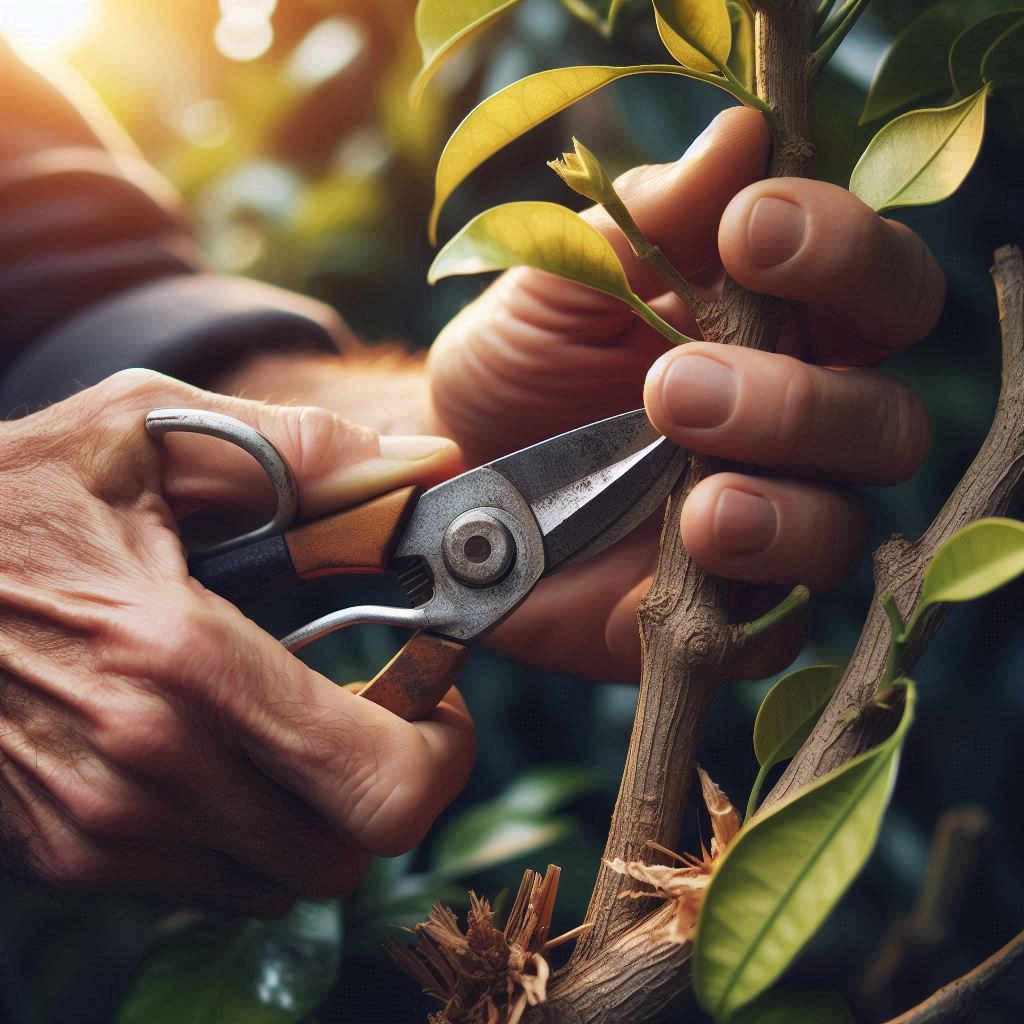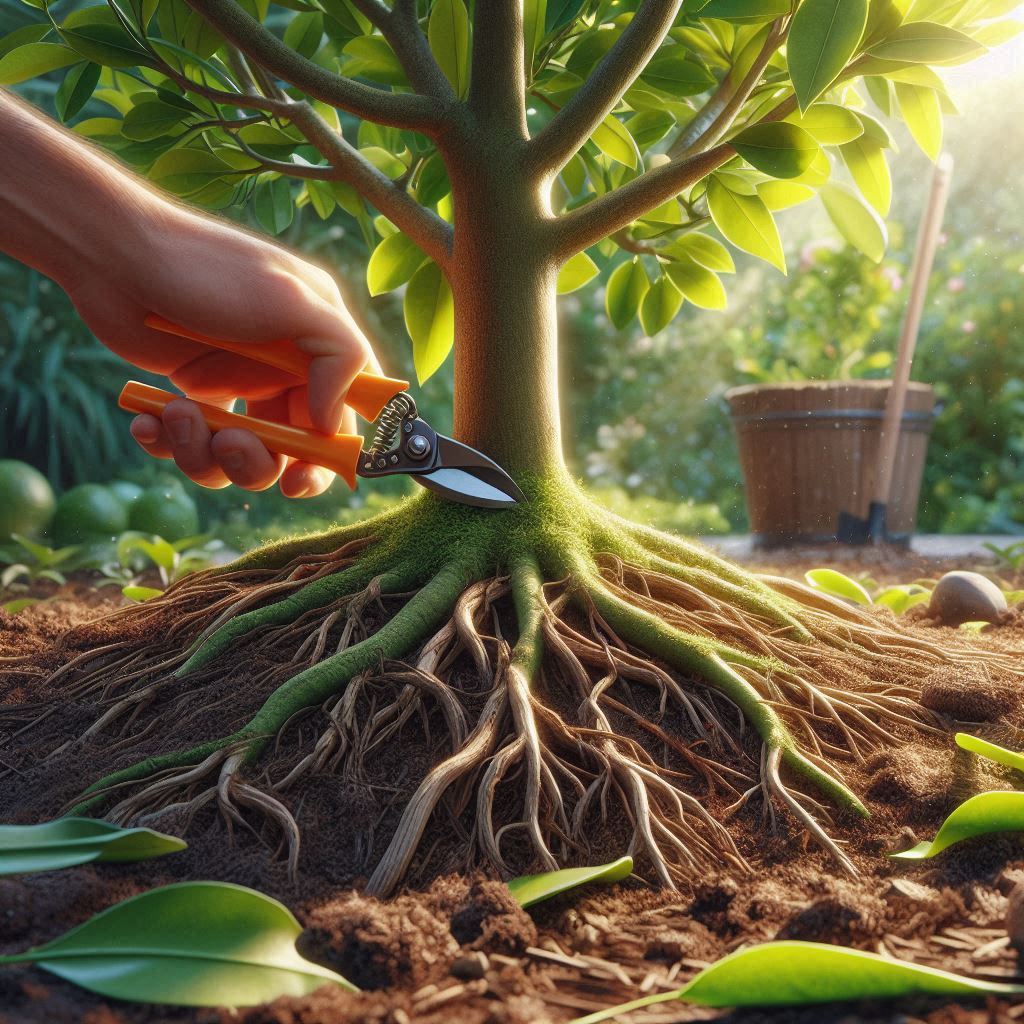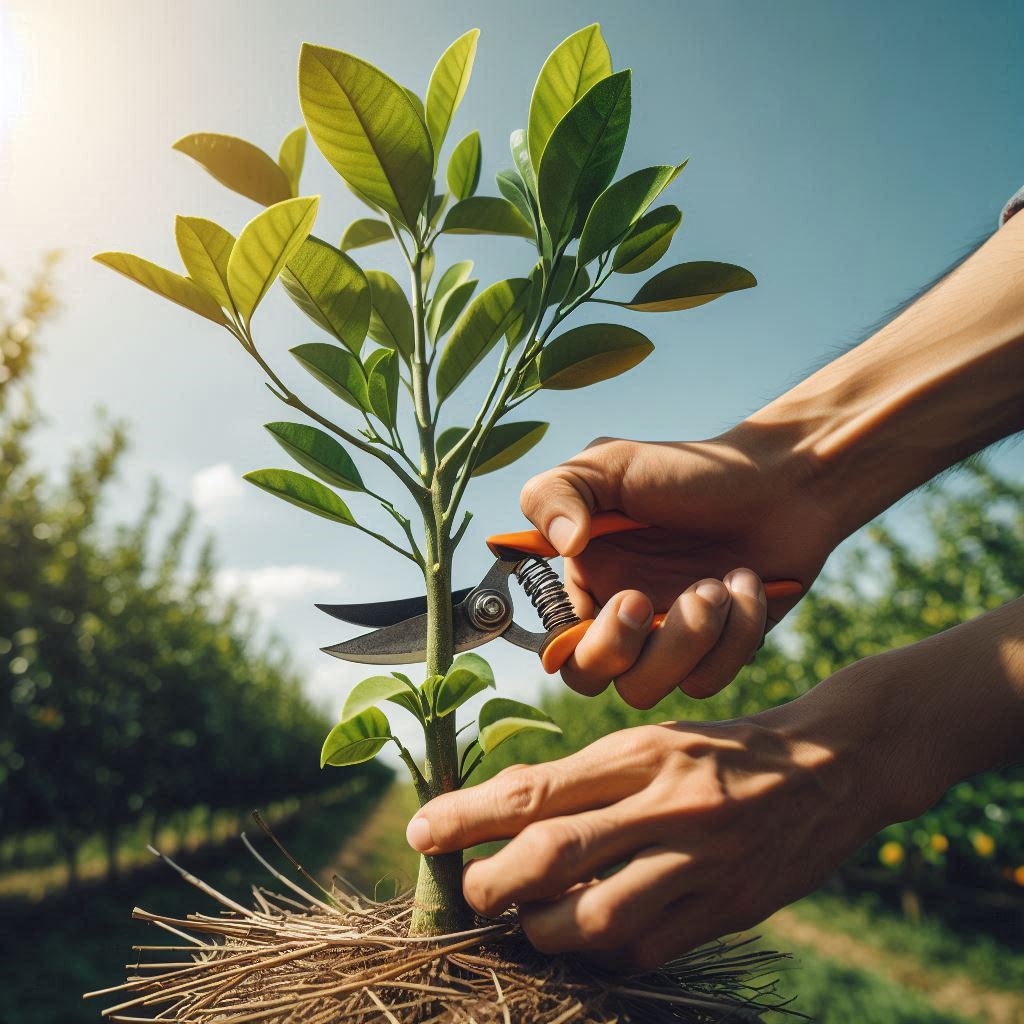A Comprehensive Guide on How to Prune Citrus Trees in 2025 for Better Growth and More Fruit

Overview
At first, mastering how to prune citrus trees may seem daunting, particularly if gardening is new to you. The fact is, however, that knowing how to prune citrus trees is not only simple, but also necessary.
Did you know that citrus yield can increase by as much as 40% with appropriate pruning? That’s correct! Mastering how to prune citrus trees properly preserves shape, promotes airflow, and enhances fruit quality, whether you’re growing lemons in containers or tending to an orange grove in your backyard.
This post explains in detail and practically everything you need to know about how to prune citrus trees, including when to do it, what tools you’ll need, and what to cut.
The Significance of Knowing How to Prune Citrus Trees

Citrus trees can maintain their health and productivity by being pruned. It prevents disease and promotes better fruit growth.
- Reduces bacterial and fungal diseases by improving airflow.
- Promotes the growth of new, fruit-bearing branches.
- Maintains the tree’s lovely and manageable shape.
- Removes energy-wasting deadwood and weak branches.
- Enhances sunlight penetration and inhibits the accumulation of pests.
In conclusion, appropriate knowing how to prune citrus trees guarantees that your tree will remain healthy and productive for many seasons.
The Ideal Season for Citrus Tree Pruning

Your citrus trees will recover more quickly and yield the best fruit if you know when to prune them.
- In temperate climates, the ideal period is early spring, following the last frost.
- After harvest but before the next blooming cycle, prune in tropical regions.
- Steer clear of pruning during periods of intense heat or frost.
- Aim for early spring to midsummer for citrus in containers.
Proper pruning maximizes growth and shields your trees from stress.
The Equipment You’ll Need to Prune Citrus Trees

Pruning your trees is easier and healthier when you use the proper equipment.
- Hand pruners: for small branches and suckers
- Loppers: for medium-thick branches
- Pruning saw: about for older trees or those with thick limbs
- Tools should be cleaned and sharpened. To achieve clean cuts, clean and sharpen your tools before using them.
- To stop the spread of disease, clean between trees.
When pruning, well-maintained equipment reduces the risk of damage and disease.
Deciding Which Branches to Remove and What to Prune

Selecting the appropriate branches to trim improves fruit quality and helps shape the tree.
- Take out any damaged, diseased, or dead wood.
- Remove any branches that are rubbing or crossing.
- Get rid of water sprouts and suckers, which are base shoots.
- Cut back branches that impede airflow by growing inward.
- To improve the distribution of light, keep the tree open in the middle.
Removing unwanted branches directs the tree’s energy toward healthy growth.
Detailed Guide on How to Prune Citrus Trees

Knowing how to prune citrus trees makes your pruning to be done successfully and without damaging your tree if you follow clear instructions.
- Examine the Tree Before Cutting : Examine your citrus tree from every perspective. Determine which branches are diseased, dead, or crossing. Getting rid of these is your top priority. See how the canopy lets in sunlight.
- Get Rid of Dead, Ill, or Damaged Wood: Use a saw or clean pruners. Revert to healthy wood. This stops the spread of illness and enhances general health.
- Trim Water Sprouts and Suckers : Water sprouts emerge directly from branches, while suckers grow from the base or roots. Fruit production provides the energy for these saps. Take them out entirely.
- Minimal Densities: To improve airflow and light, open the canopy. This promotes uniform fruit ripening and reduces the likelihood of fungal issues.
- Form the Tree : A balanced, rounded shape is what you want. Cut off any limbs that are too long or uneven to maintain symmetry. Additionally, keeping the height manageable facilitates future harvesting and pruning.
- Trim Branches That Are Too Vigorous : Trim some branches back if you see that they are growing much more quickly than others. This promotes consistent growth and assists the tree in concentrating its energy on fruit production, where it is most needed.
- Take a Step Back and Assess :
Take a step back and evaluate the tree’s shape after each cut. This keeps your citrus tree balanced and productive by avoiding overpruning. - Clear the Area and Get Rid of Trash :
Gather all diseased wood and trimmings. They may harbor diseases or pests, so don’t leave them close to the tree. Only healthy pruned material should be composted.
Mastering how to prune citrus trees gradually increases fruit production and preserves tree health.
How to Prune Citrus Trees: Young vs. Mature

How to prune citrus trees involves different pruning techniques needed for trees of varying ages.
- Young trees should be shaped with light cuts and trained under a strong central leader.
- Mature trees: Take care of them by trimming any tangled or weak branches.
- Pruning older trees once a year keeps them compact and productive.
- Pruning dwarf citrus trees promotes bushy growth.
Pruning a tree according to its age maintains its health and productivity over time.
✂️ How to Prune Citrus Trees to Get the Most Fruit
Many gardeners learn how to prune citrus trees primarily for aesthetic reasons, but the ultimate objective is to produce more and better fruit. Knowing how to prune citrus trees strategically will guarantee that its energy is directed toward fruitful branches rather than deadwood or overcrowded growth.
In order to increase fruit production:
- To increase the amount of sunlight that reaches developing fruit, thin the canopy.
- To increase air circulation and lessen the risk of fungus, cut off branches that face inward.
- To encourage outward growth and flowering, keep lateral branches apart.
You can encourage your tree to yield more fruit each year that is larger, juicier, and more plentiful by employing these techniques consistently.
How to Prune Citrus Trees That are Overgrown
It is possible to restore your citrus tree if it hasn’t been pruned in a long time. Trees that are overgrown frequently have poor air circulation, low fruit yields, and a higher risk of disease. Knowing how to prune citrus trees that are overgrown can rejuvenate even the most neglected specimen.
Begin by:
- First, cut off any large, diseased, or dead limbs.
- Removing thick clumps of branches that obstruct airflow and sunlight.
- Reducing height gradually over a number of seasons will prevent the tree from being shocked.
The key is patience. Don’t trim more than 25% of the tree in a single year. Your tree will recover more robustly and healthily with the right care.
Maintaining and Cleaning Your Pruning Equipment
Just as crucial as understanding how to prune citrus trees is taking good care of your pruning equipment. Rough cuts from dirty or dull tools can promote illness and delay healing. Here’s how to keep them in good condition:
- Sterilize tools by wiping them with alcohol or a bleach solution both before and after use.
- Sharpen blades regularly using a whetstone or sharpening tool.
- To prevent rust and deterioration, keep tools in a dry location.
In addition to being simpler and safer, clean cuts made with well-maintained equipment promote quicker recovery and improved tree health overall.
Tips on How to Prune Citrus Trees Indoor or on a Balcony
How to prune citrus trees involves care especially for citrus trees grown in pots. To maintain the plant’s health and productivity in these small areas, frequent, gentle trimming is required. Knowing how to prune citrus trees in containers makes a big difference, whether you’re growing lemons indoors or maintaining a small lime tree on your balcony.
Adhere to these crucial guidelines:
- To keep shape and control size, pinch back new growth on a regular basis.
- Any branches that hang over the pot or obstruct the airflow near windows should be cut off.
- Keep the tree’s middle section exposed to the sun.
Citrus trees grown in containers typically grow more quickly and require more frequent shaping, but with the correct care, you can eat fresh fruit straight from your windowsill.
Typical Errors to Avoid on How to Prune Citrus Trees

Steer clear of common blunders to protect your tree and increase yields.
- Pruning too much stresses the tree and lowers its yield.
- Cutting in the incorrect time of year.
- Utilizing unclean or dull tools, which can lead to illness.
- Cutting off too many branches of fruiting wood.
- Using the branch collar as a guide will help you avoid cutting at the wrong angle.
Avoiding mistakes guarantees that your citrus tree will benefit from pruning rather than suffer damage.
Tips for Citrus Tree Maintenance After Pruning

After pruning, proper maintenance promotes your tree’s recovery and health.
- Don’t overwater the tree, but give it plenty of water.
- Mulch to shield the roots and hold onto moisture.
- Keep an eye out for illness or insect infestations.
- Two to three weeks after pruning, apply a balanced fertilizer.
- Wound sealant should not be applied unless it is absolutely required.
Strong growth and copious fruit are supported by proper post-pruning care.
Notes Particular to How to Prune Citrus Trees for Various Citrus Types

For best growth, how to prune citrus trees depends on the variety of the citrus tree.
- Lemon trees: Grow quickly; prune more often.
- Orange trees: Maintain an open canopy; they are more structured.
- Lime trees: Encourage outward shoots to promote thin growth.
- Pruning is necessary to control the height of tall grapefruit trees.
- Citrus grown in containers: Lighter pruning but more frequent.
Knowing the type of tree you have determines how to prune citrus trees for best results.
We aalso have guidelines of how to prune fig trees and wisteria
How to Prune Citrus Trees to Design Landscapes
Citrus trees can be pruned to produce beautiful shapes that improve the aesthetics of your garden in addition to producing fruit. Understanding how to prune citrus trees for aesthetic purposes aids in maintaining balanced growth and clean lines, regardless of your preference for formal hedges, espalier designs, or naturally rounded canopies. Frequent shaping enhances airflow and sunlight exposure, which benefits the tree’s health and fruit quality in addition to making it look nice.
Promoting Root Health During Citrus Tree Pruning

Knowing how to prune citrus trees involves primarily targeting the branches, but it also has an indirect impact on the health and vigor of the root system. Eliminating overgrown or unhealthy foliage relieves the strain on roots, enabling them to concentrate on growth and nutrient absorption.
Because the roots may not require as much moisture right away after pruning, it’s crucial to avoid overwatering. However, strong root development is encouraged by maintaining constant soil moisture.
Following pruning, mulching the base helps control temperature and hold onto soil moisture, shielding roots from stress. Strong roots help trees become more resilient overall, produce better fruit, and recover from pruning operations more quickly. 🌿
How to Prune Citrus Trees to Reduce the Risk of Disease and Pests
In order to keep pests and diseases under control in citrus trees, proper pruning is essential. Reducing hiding places for insects and fungi to flourish can be achieved by quickly removing dead or diseased branches.
By increasing air circulation, opening the canopy hinders the ability of fungal spores to settle and proliferate. When pruning, check your tree frequently for indications of infection or infestation. To stop the spread, trim any branches that exhibit damage or unusual growth.
Cross-contamination is also reduced when tools are kept clean in between cuts. Mastering how to prune citrus trees is an essential preventative measure to maintain a healthy, pest-resistant citrus orchard that consistently yields high-quality fruit, in addition to giving the tree a distinctive shape. 🌱
Developing Stronger Structure in Young Citrus Trees

Mastering how to prune citrus trees is crucial to their development of a robust, well-balanced structure. Establish a central leader, or the main vertical stem, and promote the growth of outwardly spaced lateral branches.
To avoid structural issues later on, get rid of any rival leaders or crossing branches as soon as possible. Harvesting is made easier and the tree is better able to support fruit loads thanks to this shaping.
Additionally, it increases airflow and light exposure, which lowers the risk of disease. The groundwork for robust growth and increased fruit yields in maturity is laid by regular, mild pruning in the tree’s early years. Long-term, healthier, more fruitful citrus trees are the result of proper training.
Mastering How to Prune Citrus Trees as a Natural Pest Control Method

In addition to encouraging healthy growth, knowing how to prune citrus trees can aid in the natural control of pests. Eliminating crowded, dense branches improves airflow and sunlight penetration, which makes the environment less conducive to common citrus pests like spider mites, scale insects, and aphids.
Beneficial insects like parasitic wasps and ladybugs can more easily reach your tree and feed on dangerous pests when your canopies are open. Knowing how to prune citrus trees also helps you spot early signs of infestations, allowing prompt intervention before damage spreads.
Pruning in conjunction with natural pest control helps you sustainably maintain the health of your citrus tree, encourage a balanced garden ecosystem, and lessen the need for chemical pesticides.
Enhancing Watering Techniques Following How to Prune Citrus Trees
To aid in your citrus trees’ recovery after pruning, you should modify your watering schedule. As they concentrate their energy on mending wounds and developing new branches, freshly pruned trees frequently require a little more water.
Avoid overwatering, though, as this can lead to diseases like root rot. Give the soil a thorough watering, but let it dry out a little in between applications. This promotes stronger and deeper root growth.
Mulching the base keeps roots cool, helps retain moisture, and inhibits the growth of weeds. In addition to stabilizing soil temperature, mulching lessens the stress that hot weather places on trees. Your pruned citrus tree will recover more quickly and produce better fruit if you optimize mulching and watering.
In conclusion
Your citrus trees’ health and fruit production will improve if you know how to prune citrus trees. Airflow, structure, and longevity are more important than appearances alone. This guide provides all the information you need to prune, from identifying troublesome branches to using the proper tools to make clean cuts.
FAQs About How to Prune Citrus Trees
Maintaining healthy and fruitful citrus trees requires knowing how to prune them. To help you become proficient in this area, here are some commonly asked questions about how to prune citrus trees.
What time of year is ideal for pruning citrus trees? The best time to begin pruning your citrus trees is in the early spring, right after the last frost, to guarantee robust growth and a bumper crop.
How frequently should citrus trees be pruned? Pruning once a year is usually adequate. To preserve shape and get rid of unwanted growth, light pruning can be done all through the growing season.
What equipment is required to properly prune citrus trees? A pruning saw, loppers, and hand pruners are necessary. You can make clean, healing cuts with clean, sharp tools.
How to prune citrus trees without causing damage? Avoid cutting too much at once and concentrate on getting rid of branches that are dead, diseased, or crossing. To encourage appropriate healing, always trim at the branch collar.
If I grow citrus trees in containers, can I learn how to prune them? Of course! Citrus trees grown in containers frequently need to be pruned less frequently but more frequently to keep their size and shape.
Does fruit production require pruning? Indeed, by effectively allocating the tree’s energy, proper pruning of citrus trees promotes new growth and increased fruit production.
What are some typical mistakes people make? Pruning at the wrong time of year, with dull tools, and in excess can stress the tree and lower fruit production.
